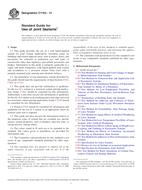Potrebujeme váš súhlas na využitie jednotlivých dát, aby sa vám okrem iného mohli ukazovať informácie týkajúce sa vašich záujmov. Súhlas udelíte kliknutím na tlačidlo „OK“.
ASTM C1193-13
Standard Guide for Use of Joint Sealants
Automaticky preložený názov:
Štandardné sprievodca pre použitie tesniacich
NORMA vydaná dňa 15.1.2013
Informácie o norme:
Označenie normy: ASTM C1193-13
Poznámka: NEPLATNÁ
Dátum vydania normy: 15.1.2013
Kód tovaru: NS-9959
Počet strán: 33
Približná hmotnosť: 99 g (0.22 libier)
Krajina: Americká technická norma
Kategória: Technické normy ASTM
Anotácia textu normy ASTM C1193-13 :
Keywords:
bond breaker, guide, joint accessories, joint filler, precured sealant, primer, sealant, sealant backing, sealant design, sealant geometry, sealant installation, sealant joint, ICS Number Code 91.100.50 (Binders. Sealing materials)
Doplňujúce informácie
| Significance and Use | ||||||||||||||||||||||||||||||||||||||||||||||||||||||||||||||||||||||||||||||||||||||
|
4.1 This guide provides information and guidelines for consideration by the designer or applicator of a joint seal. It explains the properties and functions of various materials, such as sealant, sealant backing, and primer, among others; and, procedures such as, substrate cleaning and priming, and installation of the components of a sealed joint. It presents guidelines for the use and application of the various materials, design of a sealant joint for a specific application, and environmental conditions and effects that are known to detrimentally affect a sealant joint. The information and guidelines are also useful for those that supply accessories to the sealant industry and for those that install sealants and accessory materials associated with sealant use. 4.2 In addition to the design and installation data in this guide, consult the sealant manufacturer about applications for its products and their proper use and installation. Considering the range of properties of commercially available sealants, the variety of joint designs possible, and the many conditions of use, the information contained herein is general in nature. 4.3 It should be realized that a sealant and sealant joint are expected to have a design life during which they remain functional. However, a sealant and sealant joint will also have a service life. The intent is for service life to meet or exceed design life. There are many factors that can affect service life including type of sealant polymer, sealant formulation, compatibility with adjacent materials, installation techniques or deficiencies, sealant joint design (or lack thereof), proper maintenance (or lack thereof), and environmental exposure, among others. The designer of a joint seal should take the above into consideration when designing and specifying sealants for certain applications. 4.4 The design life of a sealant or sealant joint should be considered in conjunction with the design life of the structure for which it is used. For example, a building owner may require a new courthouse building to have an expected design life of 50 years. Therefore, elements of the building's exterior envelope should, with proper maintenance, be expected to perform for that time period. As a result of the information in 4.5 To assist the user of the guide in locating specific information, a detailed listing of guide numbered sections and their descriptors are included in 1.1 This guide describes the use of a cold liquid-applied sealant for joint sealing applications. Including joints on buildings and related adjacent areas, such as plazas, decks, and pavements for vehicular or pedestrian use, and types of construction other than highways and airfield pavements and bridges. Information in this guide is primarily applicable to a single and multi-component, cold liquid-applied joint sealant and secondarily to a precured sealant when used with a properly prepared joint opening and substrate surfaces. 1.2 An elastomeric or non-elastomeric sealant described by this guide should meet the requirements of Specification C834, C920, or C1311. 1.3 This guide does not provide information or guidelines for the use of a sealant in a structural sealant glazing application. Guide C1401 should be consulted for this information. Additionally, it also does not provide information or guidelines for the use of a sealant in an insulating glass unit edge seal used in a structural sealant glazing application. Guide C1249 should be consulted for this information. 1.4 Practice C919 should be consulted for information and guidelines for the use of a sealant in an application where an acoustic joint seal is required. 1.5 This guide also does not provide information relative to the numerous types of sealant that are available nor specific generic sealant properties, such as hardness, tack-free time, or curing process, among others. 1.6 The values stated in SI units are to be regarded as the standard. The values given in parenthesis are provided for information only. 1.7 The Committee with jurisdiction for this standard is not aware of any comparable standards published by other organizations. 1.8 This standard does not purport to address all of the safety concerns, if any, associated with its use. It is the responsibility of the user of this standard to establish appropriate safety and health practices, and determine the applicability of regulatory limitations prior to use. 1.9 The committee with jurisdiction over this standard is not aware of any comparable standards published by other organizations. |
||||||||||||||||||||||||||||||||||||||||||||||||||||||||||||||||||||||||||||||||||||||
| 2. Referenced Documents | ||||||||||||||||||||||||||||||||||||||||||||||||||||||||||||||||||||||||||||||||||||||
|
Odporúčame:
Aktualizácia zákonov
Chcete mať istotu o platnosti využívaných predpisov?
Ponúkame Vám riešenie, aby ste mohli používať stále platné (aktuálne) legislatívne predpisy
Chcete vedieť viac informácií ? Pozrite sa na túto stránku.




 Cookies
Cookies
